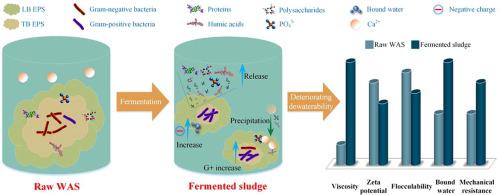Chemical Engineering Journal ( IF 13.3 ) Pub Date : 2020-09-16 , DOI: 10.1016/j.cej.2020.127026 Qiang Liu , Yifu Li , Fan Yang , Xuran Liu , Dongbo Wang , Qiuxiang Xu , Yi Zhang , Qi Yang

|
Anaerobic fermentation is a promising process to recover volatile fatty acids from waste activated sludge, but this process seriously deteriorates sludge dewaterability. Although several efforts were made in the past, the mechanism of how anaerobic fermentation deteriorates the dewatering performance remains largely unknown. This work therefore aims to fill the gap by exploring the variations in both liquid and solid phases before and after alkaline anaerobic fermentation and identifying their impacts on dewatering. Experimental results showed that 1418.6 ± 15.4 s of capillary suction time and (50.08 ± 1.37) × 1012 m/kg of specific resistance to filtration were determined in fermented sludge, which were 20.3- and 5.1-fold of those measured in raw sludge. The mechanism explorations revealed that anaerobic fermentation increased proteins, polysaccharides, humic acids and PO43- concentrations but decreased Ca2+ amount in liquid phase. The increases of proteins and humic acids increased the viscosity but decreased the zeta potential of liquid. The decline of Ca2+ not only decreased the zeta potential but also deteriorated the flocculability. The increase of PO43- decreased the zeta potential while the increase of polysaccharides increased the viscosity. Among these components, the release of humic acids was identified to the major contributor to the deterioration of sludge dewatering. Besides, anaerobic fermentation increased loosely bound extracellular polymeric substances, which benefited fermented sludge to wrap water especially bound water and enhanced sludge viscosity. It was also found that anaerobic fermentation caused transformation of microbes from Gram-negative to Gram-positive, which increased the resistance of mechanical forces and negative charges on sludge flocs.
中文翻译:

了解厌氧发酵如何使污泥脱水性恶化的机理
厌氧发酵是一种从废活性污泥中回收挥发性脂肪酸的有前途的过程,但是该过程严重降低了污泥的脱水能力。尽管过去已经做出了一些努力,但是厌氧发酵如何使脱水性能恶化的机理仍然是未知的。因此,这项工作旨在通过探索碱性厌氧发酵前后液相和固相的变化并确定其对脱水的影响来填补空白。实验结果表明,毛细管抽吸时间为1418.6±15.4 s,(50.08±1.37)×10 12在发酵污泥中确定了m / kg的过滤抗性,是原始污泥中的20.3到5.1倍。机制探索表明,厌氧发酵增加了蛋白质,多糖,腐殖酸和PO 4 3-的浓度,但降低了液相中Ca 2+的含量。蛋白质和腐殖酸的增加增加了粘度,但降低了液体的ζ电位。Ca 2+的下降不仅降低了ζ电位,而且使絮凝性恶化。PO 4 3-的增加降低zeta电位,而增加多糖则增加粘度。在这些成分中,腐殖酸的释放被认为是造成污泥脱水恶化的主要原因。此外,厌氧发酵增加了松散结合的细胞外聚合物,有利于发酵污泥包裹水,尤其是结合水,并提高了污泥粘度。还发现厌氧发酵导致微生物从革兰氏阴性转化为革兰氏阳性,这增加了对污泥絮体的机械力和负电荷的抵抗力。











































 京公网安备 11010802027423号
京公网安备 11010802027423号